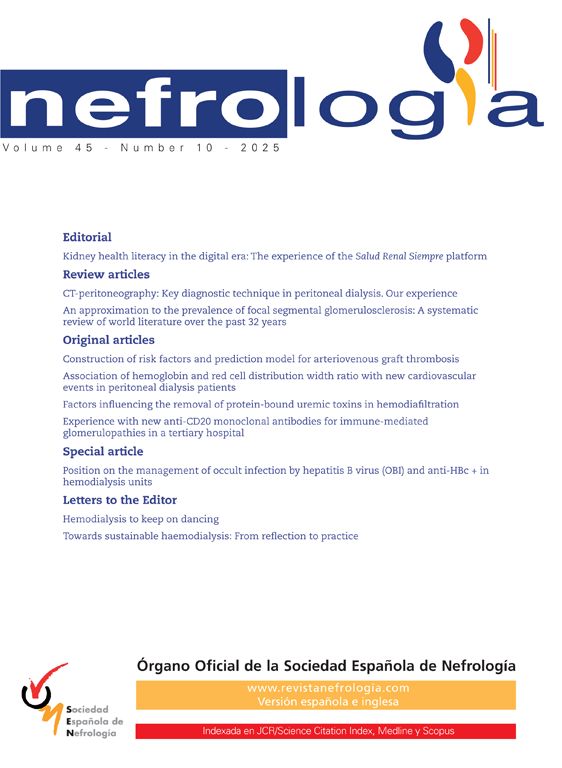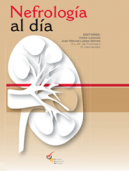To the editor: Emphysematous pyelonephritis is a serious disorder that mainly affects diabetic patients.
We present a case of torpid emphysematous pyelonephritis.
A 72-year-old patient presented with a history of chronic liver disease (of probable alcoholic origin) with occasional
edematous decompensation and several digestive bleeding episodes, colon diverticuli, pericardiectomy due to constrictive pericarditis, and chronic renal failure (of indeterminate origin) with the start of peritoneal dialysis in
2003.
The patient was admitted in October 2007 due to sepsis of urinary origin ¿ the causal microorganism being E. coli.
During admission, abdominal ultrasound showed small kidneys, with no other anomalies. Treatment was provided
in the form of amoxicillin-clavulanate for three weeks, the patient remaining at home without clinical symptoms.
In December 2007 he was admitted to the Service of Nephrology due to pain in the left inguinal region and leukocytosis (35,000). The patient was without fever, hemodynamically stable and presented no other symptoms. Exploration of the affected zone revealed no alterations other than pain in response to pressure. Empirical antibiotic treatment was started with ciprofloxacin, and emergency ultrasound of the inguinal region revealed the presence of an abscess measuring 3 cm in size. After 24 hours, the patient presented abdominal pain and turbid dialysis fluid. An emergency abdominal CAT scan was thus decided, revealing (fig. 1) a waterfluid level accumulation in the retroperitoneum and left renal fossa, and abundant gas bubbles occupying the region of the psoas muscle, which appeared atrophic. The accumulation was seen to descend between the muscles of the root of the left thigh, with an abundant presence of gas.
In view of the CAT findings, emergency surgery was decided under broad-spectrum antibiotic coverage (piperacillin-tazobactam plus metronidazole), performing a left lumbotomy and drainage of the abscess. The peritoneal dialysis catheter was removed, and the patient was kept under continuous venous-venous hemodiafiltration.
The urine and peritoneal dialysis fluid cultures proved positive for E. coli sensitive to the previously administered
antibiotic treatment.
Six days later, and in view of clinical worsening of the patient, repeat surgery was carried out to remove the left kidney and perform retroperitoneal debridement.
However, deterioration was progressive, and the patient died after 24 hours.
Emphysematous pyelonephritis is an infrequent acute disease characterized by the presence of gas within the renal
parenchyma, and presents a high percentage mortality.
The condition is generally unilateral and affects patients with known risk factors, such as diabetes mellitus or urinary tract obstruction ¿ though it has also been reported that the use of dextrose in the peritoneal dialysis fluid may be a risk factor for infections of this kind.1
In most cases the isolated germ corresponds to E. coli.2
Treatment is the subject of controversy. Percutaneous drainage should be considered initially, and particularly in
critically ill patients. With such treatment a lesser percentage mortality has been reported compared with emergency nephrectomy. However, subsequent kidney removal may prove necessary in some cases.3,4
The Impact Factor measures the average number of citations received in a particular year by papers published in the journal during the two preceding years.
© Clarivate Analytics, Journal Citation Reports 2025
SRJ is a prestige metric based on the idea that not all citations are the same. SJR uses a similar algorithm as the Google page rank; it provides a quantitative and qualitative measure of the journal's impact.
See moreSNIP measures contextual citation impact by wighting citations based on the total number of citations in a subject field.
See more




